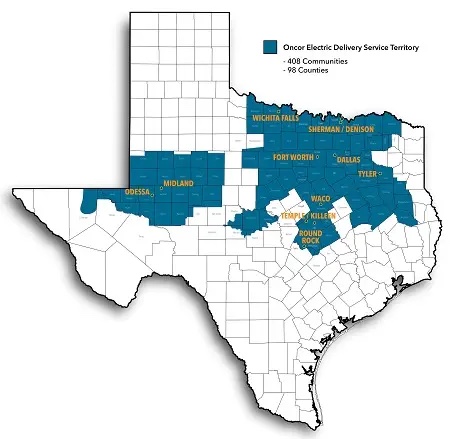Updated 8 months ago
Should Texas homeowners go solar with Oncor Electric Delivery?
Written by
Catherine Lane

Find out what solar panels cost in your area
Homeowners everywhere have reservations about going solar, especially because the process is so intimidating. It can be difficult to figure out who to trust, what to do first, and even what options are available near you.
The process is even more complicated in Texas, thanks to the state’s deregulated electricity market. Not only do homeowners have to find a solar installer, but also they need to shop around for the best solar buyback plan from a Retail Electric Provider, plus figure out what their utility requires when going solar.
There are five utilities in the deregulated area of the Lone Star State, the largest of them being Oncor Electric Delivery. It can be hard to figure out where Oncor fits into the process of going solar and what you need to do to get your system up and running, so let’s break it down.
Going solar with Oncor at a glance:
-
Oncor Electric Delivery is a transmission and distribution utility, meaning it maintains electrical equipment and the grid’s transmission system, but is not responsible for electric rates.
-
Texans looking to go solar must find a Retail Electric Provider to purchase electricity from that operates in Oncor’s service territory and offers a solar buyback program. They include Reliant, TXU Energy, and Rhythm.
-
Oncor offers an incentive to homeowners in its territory who install solar-plus-storage systems on their property. Incentive amounts vary based on system characteristics like size, direction, tilt, and panel type.
-
After Oncor approves the solar application submitted by your installer, it will issue an interconnection agreement and give you permission to operate.
-
Homeowners in Oncor’s territory can save a decent amount of money on their electricity bills by going solar, so long as they pick the right plan from their REP.
What areas of Texas does Oncor Electric Delivery service?

Image source: Oncor
Oncor services 98 counties across central and west Texas, including major cities like Dallas and Fort Worth.
Keep in mind that Oncor is a transmission and distribution utility, meaning you do not buy your electricity from the company. Your electricity is purchased from a Retail Electric Provider (REP) that you get to choose yourself.
Oncor’s job is to deliver the electricity to homes and businesses, as well as maintain the physical pieces that make up the grid, like poles and power lines.
Picking a REP is kind of like shopping for a cellphone plan - you look at all of the electricity rate plans offered by the REPs in your area, and pick the one that makes the most sense for you. While these rate plans do include transmission and distribution utility (TDU) fees that get paid to Oncor, the actual electricity payments go to the REP.
What REPs can you choose in Oncor Electric Delivery’s territory?
There are a ton of Retail Electric Providers to choose from in Oncor’s territory, and each one offers different rates and terms. The following table outlines some of the solar plans offered by REPs in Oncor’s electric service area:
REP | Plan | Average purchase rate* | Solar buyback rate* |
|---|---|---|---|
12-Month Solar Payback Plan | $0.149 per kWh | $0.149 per kWh, up to your monthly energy usage | |
36-Month Renewable Buyback Plan | $0.20 per kWh | $0.14 per kWh | |
Rooftop Solar Buyback 12 | $0.14 per kWh | $0.097 per kWh, up to monthly energy usage | |
Gexa Solar 36 | $0.17 per kWh | Does not purchase excess solar generation | |
Maxx Saver Select | $0.15 per kWh | Does not purchase excess solar generation |
*Rates may vary depending on location and energy usage
As a solar customer, you want to make sure the REP you choose offers a solar buyback rate. Reliant, TXU Energy, and Rhythm all purchase excess solar electric power generated by your solar panels, but you’ll need to consult the company to find out the specific terms of each plan.
Oncor’s solar incentive program
Oncor offers a solar incentive for homeowners who live in its service area. To qualify, your system must be between 3 kilowatts (kW) and 15 kW in size, and it must be installed with a solar battery. The system cannot be facing north, and there are also tilt angle requirements that vary, depending on your home’s location.
Unlike most solar incentive programs, Oncor doesn’t offer a set incentive rate for all solar systems. Instead, the value of the incentive is dependent on a number of factors, including:
The tilt of the system
The direction of the system
The number of panels installed
The solar panels you use
The location of your home
The solar installer you choose will be able to determine the value of the incentive your system qualifies for, or you can experiment with different solar system characteristics in Oncor’s incentive calculator here.
Don’t expect a check! The incentive goes directly from Oncor the solar installer, who will then pass the savings onto you through a lower installation cost.
How much will Oncor’s solar incentive save you on installation costs?
Let’s say you live in Dallas and installed a 7.2 kW solar panel system made up of 360-watt Qcell panels. Assuming the system is installed on a south-facing roof plane with an average roof pitch and typical shading, you would receive an incentive of $4,402 from Oncor.
The initial cost of this 7.2 kW solar-plus-storage system (remember, you need a battery in order to claim this incentive!) in Dallas would come out to about $29,800 before any incentives are considered. Once you take Oncor’s incentive into account, the price drops to about $25,400.
Then when you add the 30% federal solar tax credit, the price falls again to $17,780. That means you would save roughly $12,000, thanks to the incentives!
You don’t have to use the Oncor solar incentive if you don’t want to! Because Oncor’s incentive requires you to pair the system with a solar battery, the upfront cost of the installation will be much higher (yes, even with the incentive). In fact, your solar system can actually pay for itself a little bit faster if you install just solar panels and don’t opt for the incentive. That said, if you want battery backup during power outages, then taking advantage of the Oncor incentive is a no-brainer.
Oncor Electric Delivery’s solar interconnection process
We wish that going solar was as simple as finding an installer and having the panels magically installed on your roof. Unfortunately, there is a bit of paperwork and a handful of steps involved. The good news, however, is that your solar installer will handle nearly all of it for you.
Overall, the interconnection process can take anywhere from a few days to a couple of months, depending on what types of permits and inspections might be required in your municipality.
Once you choose an installer, here’s what you can expect from the going-solar process with Oncor:
1. Solar application submission and approval
After you have hired your installer, they’ll get the ball rolling on your paperwork, which entails sending a tariff application to Oncor. You’ll have to sign the application, but the submission is taken care of by the installer.
Once the application is submitted, Oncor will review it and conduct a study to ensure that the system can be safely integrated with the grid. Oncor does not provide a timeframe for how long this process can take, but typically these types of reviews take just a few days to two weeks to complete.
2. Interconnection agreement
Upon approval of the application and grid study, Oncor prepares an interconnection agreement, which is sent to the installer, who then forwards it to you to sign. The installer is then processed in Oncor’s online installer portal, and is signed off on by Oncor.
Important note! Most REPs require you to provide a copy of your interconnection agreement before you can sign up for a solar buyback plan. So, until your interconnection agreement is finalized, you probably won’t be able to select a new solar REP plan. Keep this timing in mind, because you may end up having to pay a cancellation fee if you need to use a different plan before your interconnection agreement is available.
3. Permission to operate
Once the interconnection agreement has been signed by all parties and is reviewed by Oncor, Oncor will grant your system the permission to operate.
When that happens, Oncor will program your electric meter to measure the energy your solar system produces and sends to the grid, as well as any energy you take from the grid.
It can take between 30 to 60 days for surplus energy generation information to be sent to your REP.
Is going solar with Oncor Electric Delivery worth it?
If you’re an Oncor Electric Delivery customer, going solar is a great way to lower the average electric bill in Texas and reduce your reliance on the utility. But keep in mind, it’s less about being an Oncor customer, and more about which REP you choose. Make sure you choose an REP that offers a solar buyback program, otherwise, solar panels won’t be a worthwhile investment.
Switching to solar is especially great for Oncor customers who want to pair solar panels with a battery. The electric utility’s solar incentive program can save you thousands of dollars on a solar-plus-storage installation and provide peace of mind that you’ll have backup power when the grid goes down. This is a major factor to consider, especially for homeowners in Texas who have experienced prolonged blackouts, thanks to unreliable utility service.
The best way to find out how much you can save with solar in Oncor’s territory is by utilizing our state-of-the-art solar calculator. Not only does the calculator give you an accurate estimate of how much solar can save you, it can also give you an idea of how battery storage will impact your investment.
Catherine has been researching and reporting on the solar industry for five years and is the Written Content Manager at SolarReviews. She leads a dynamic team in producing informative and engaging content on residential solar to help homeowners make informed decisions about investing in solar panels. Catherine’s expertise has garnered attention from leading industry publications, with her work being featured in Solar Today Magazine and Solar ...
Learn more about Catherine Lane